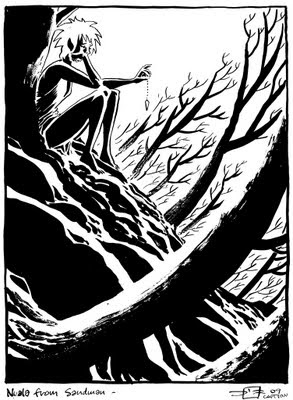
Nuala from Sandman: The Kindly Ones, a convention sketch for CAPTION 2009
Sandman © 2009 Vertigo/DC Comics
Sandman created by Neil Gaiman & Sam Keith
Sandman © 2009 Vertigo/DC Comics
Sandman created by Neil Gaiman & Sam Keith
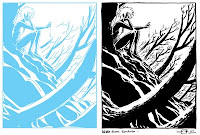 CAPTION has been and gone for another year; it's the 18th one, and it had its own cake to celebrate its coming of age (see my photos on Flickr).
CAPTION has been and gone for another year; it's the 18th one, and it had its own cake to celebrate its coming of age (see my photos on Flickr).Left: Digital "pencils" printed out in blue and (gasp) real inks! How very analogue!
Every year I produce a sketch for the CAPTION auction. These sketches are one of the few times each year I still produce finished artwork on paper, though even for this I "pencil" digitally and print the drawing out in pale blue for inking by hand. The fact that CAPTION has become a last outpost of my real-media output is really rather ironic, as ten years ago it marked my first steps into the world of pure digital production.
Back in 1999 I was working as a colourist for 2000AD using my rickety old Power Computing Mac clone. I'd been on a real shoestring budget when I bought that first computer kit, so I was forced to postpone buying a graphics tablet; I can't believe now that for my first eight months as a professional colourist I did everything with a mouse. By May 1999, I was doing well enough to consider getting a tablet, but wasn't sure if it was worth the outlay.
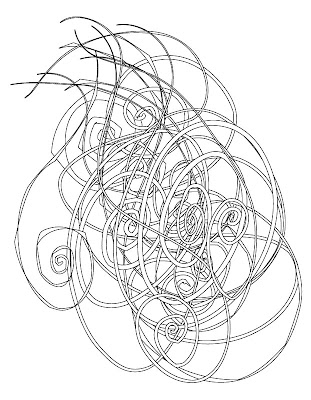
My first-ever try at drawing with a Wacom tablet - thanks to Jeremy Dennis for letting me play with her toys.
Luckily for me, my good friend, the small-press cartoonist Jeremy Dennis, owned exactly the model of Wacom tablet I was thinking of buying, and was willing to let me give hers a try. When you first try using a tablet, the business of having your hand down on the tablet, but whatever you're drawing appearing up on a screen in front of you, is very awkward and distracting (above, you can see one of the test scribbles I made at the time). I quickly dismissed the idea of doing precision drawing with the tablet, but reckoned that, with a little practice, it would be useful for adding highlights and shading when colouring. I bought an ADB Wacom Intuos I A5 tablet soon after, and within a few days it was starting to pay for itself in improved productivity and quality of work.
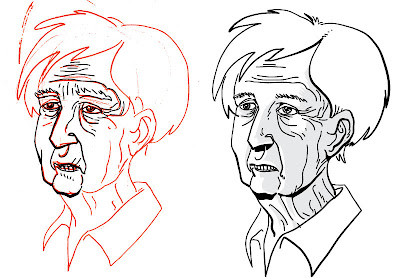
First attempt at inking, in Illustrator, over a scanned drawing (in red, on the left hand version).
After a few weeks of using the tablet on a daily basis for colouring, I was starting to become comfortable with it, and I decided to revisit the idea of drawing.It occurred to me that previously I'd made the mistake of assuming I could just do a finished drawing straight off - without the equivalent of pencils - something I certainly couldn't do with an ordinary pen and paper. My first thought was to do a pencil drawing and trace it by laying it on the tablet (the translucent plastic cover over the working surface of the Wacom tablet even lifted up to help you do this). However,
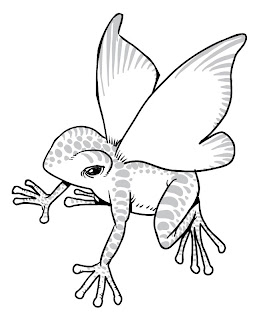 because the tablet was set to map its full area to the full area of the screen (and the screen had different proportions to the tablet), the resulting tracing was rather distorted. I could have fiddled with the mapping settings, but a better idea occurred to me: scan in the pencils, that way I could zoom in to the drawing for better control when inking fiddly fine details (see above). This worked so well that I started to realize I didn't need the scanned pencils - I could just do my "pencils" with the Wacom tablet too.
because the tablet was set to map its full area to the full area of the screen (and the screen had different proportions to the tablet), the resulting tracing was rather distorted. I could have fiddled with the mapping settings, but a better idea occurred to me: scan in the pencils, that way I could zoom in to the drawing for better control when inking fiddly fine details (see above). This worked so well that I started to realize I didn't need the scanned pencils - I could just do my "pencils" with the Wacom tablet too.Mister Wingéd Frog here is my first attempt at a finished Wacom drawing - and done entirely in Illustrator from beginning to end.
My first all-digital drawing, shown here (left), was finished less than half an hour later. Daft as it looks, it was my first step into a new way of working. My professional life was about to change forever.
SpaceCAPTION:1999: The Frightwig Factor - three-page comic strip for the 1999 CAPTION small press convention booklet. This was the first complete strip I ever drew entirely on computer, using Adobe Illustrator 7 and an A5 Wacom Intuos 1 graphics tablet. Click on the pages to view a readable version on Flickr.
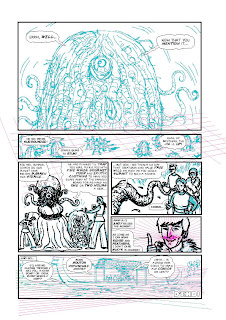
By the summer of 1999, I'd been playing around with drawing in Adobe Illustrator, and my co-ordination with the tablet was improving with every drawing. With the new millennium coming up, there was very much a sense of living in the future (at least the future presented to us in our childhood TV shows). With that in mind, that year's CAPTION small-press comic convention was christened SpaceCAPTION:1999 (in honour of Gerry Anderson's 1975 TV series Space:1999 in particular and all things retro-futuristic in general.) I decided it would be fun to contribute a short strip that mixed the real contributors to CAPTION with the fictional world of Space:1999. And in the spirit of futurism, I'd make it my first all-digital strip.
Left: this part-finished page includes my first attempts at building perspective grids using the blend tool in Adobe Illustrator.
So off I set, armed with my trusty tablet, a copy of Adobe Illustrator 7, and a grim determination. I was working all day every day on colouring, so I'd get up an hour early to do a panel or so each morning before work. My main memory of the strip is sitting in my workroom with a flood of early morning sunshine filtering through the drawn curtains, feeling this sense of intense excitement, of new possibilities opening up before me as I drew.
Left: this part-finished page includes my first attempts at building perspective grids using the blend tool in Adobe Illustrator.
So off I set, armed with my trusty tablet, a copy of Adobe Illustrator 7, and a grim determination. I was working all day every day on colouring, so I'd get up an hour early to do a panel or so each morning before work. My main memory of the strip is sitting in my workroom with a flood of early morning sunshine filtering through the drawn curtains, feeling this sense of intense excitement, of new possibilities opening up before me as I drew.
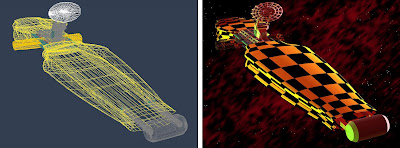 The alien spacecraft, constructed in Ray Dream Studio 3D. I returned to this technique 5 years later for Scarlet Traces: The Great Game and still use 3D models for reference.
The alien spacecraft, constructed in Ray Dream Studio 3D. I returned to this technique 5 years later for Scarlet Traces: The Great Game and still use 3D models for reference.What surprises me, looking at these pages again, is how much of my computer-drawing technique was in place from day one; the rough pencils for page three (above left) shows me already trying to build perspective grids using Illustrator's Blend tool. On page two the Eagle spacecraft was traced from a scanned photo from an old annual (I was on a 28k dial-up Internet connection in those days, so no Google image search!). On page one panel four the alien spacecraft was assembled a 3D application (Ray Dream Studio, the grandaddy of the Carrara application I use today), rendered and placed beneath the page for tracing (see above).
Ten years on, with over 700 pages of digital art under my belt, it does me good to remember the excitement I felt in those early days. I keep trying to shake things up and find new ways of working, but for me there'll probably never be another such revolutionary shift in working methods.
I'm not and never have said "this is the future" for everyone; working digitally solved and awful lot of problems for me, many of which were to do with poor hand-to-eye co-ordination; most other artists will never have need of the solutions I found. But it's wonderful to think of the things that are still out there to explore, and exciting to see the discoveries others have made on the way.
See you in the funny pages.
Ten years on, with over 700 pages of digital art under my belt, it does me good to remember the excitement I felt in those early days. I keep trying to shake things up and find new ways of working, but for me there'll probably never be another such revolutionary shift in working methods.
I'm not and never have said "this is the future" for everyone; working digitally solved and awful lot of problems for me, many of which were to do with poor hand-to-eye co-ordination; most other artists will never have need of the solutions I found. But it's wonderful to think of the things that are still out there to explore, and exciting to see the discoveries others have made on the way.
See you in the funny pages.
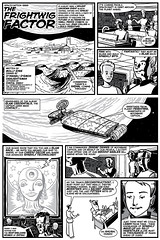
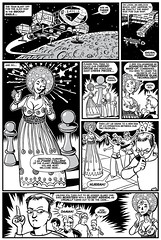
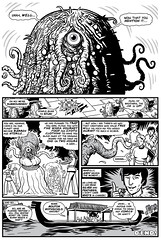

8 comments:
Another excellent insight into your digital art. You are an inspiration! Many thanks Matt
Awesome tutorial. Thanks for posting!!!
Love what you do it is very good
Can I see the influence of Spanish cartoonist Max in the trees in your new Caption illustration?
Mike, Larry, dolls - cheers!
Mikal - Hadn't thought of it like that, but yes, I absolutely love Max's work!
Fantastic blog Matt, and fantastic post. Wandered over here from WKRR and thought this was a really interesting bit of history. I've worked in vectors for a while, but in the more 'traditional' Rian Hughes vein and it's great to see the fantastic achievements you've made with illustrator. I've recently started trying to push more in the direction my work was heading back in the day of pen and ink, and it's so inspiring to see what can be achieved. But enough about me! Keep up the great work, and thanks for taking the time for such informative posts.
wow man! great job!
Hi. I really appreciate you for all the valuable information that you are providing us through your blog.
Post a Comment